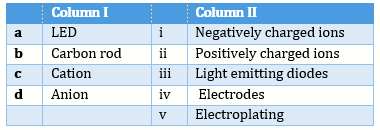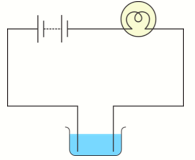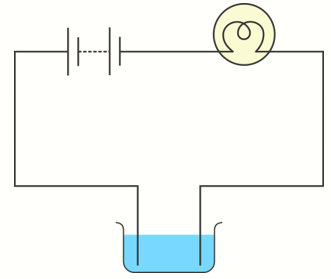Chemical Effects of Electric Current Worksheet
Objective Type Questions
- Match items in column I (Term) with the item in column II (Function):
State whether the statement is true or false: - Electroplating is done on a metal surface to prevent the user from getting shocked.
- Fill in the blanks:
i. The passage of an electric current through a conducting solution cause ______________.
ii. Most liquids that conduct electricity are solutions of acids, ________ and __________.
iii. The path through which an electric current flow is called___________. - Unscramble the following words:
i. OELERTCDE
ii. LATCELERTINOGP - Pick the odd one out:
Copper, Vegetable oil, Lemon juice, salt water.
Multiple Choice Questions - What effect does an electric current produce when passed through a wire?
(a) Heating effect
(b) Chemical effect
(c) Magnetic effect
(d) All of the above - An electroplating factory has waste that needs to be disposed of, where should this waste be disposed of?
(a) in the nearby river
(b) in the nearby pond
(c) in the nearby cornfield
(d) according to the disposal guidelines of the local authority
- While exploring his uncle’s car repair shop, Arjun noticed that certain parts had shiny and corrosion-resistant surfaces. Which metal is commonly used in electroplating to achieve this effect?
(a) Iron
(b) Copper
(c) Chromium
(d) Aluminum - Which chemical effects are observed when an electric current passes through a copper sulphate solution?
(a) Formation of bubbles.
(b) Change in colour.
(c) Deposition of copper on the electrode.
(d) Realise of oxygen gas. - Priya wants to electroplate a jewellery piece with a layer of silver. Which metal should she use as the base material for electroplating?
(a) Gold
(b) Copper
(c) Brass
(d) Silver
SAQs - Shradha adds a couple of sugar cubes in distilled water. Will the solution conduct electricity?
- A child in a coastal region tests the drinking water and sea water with his tester setup, as shown below.
He finds that the compass needle deflects more in the case of seawater. Can you explain the reason?
- While experimenting, Seema noticed that the bulb did not illuminate in the setup below. What may be the cause of this failure?
- According to our testers, can a solution, which is a poor conductor of electricity, ever allow the electric current to pass through it? Give a common example.
- How will you modify an electroplating circuit to indicate that the electroplating process is over clearly?
- Mention three common solutions that are good conductors of electric current. What is common in these solutions?
Assertion-Reasoning Questions
Select the correct answer to these questions from the codes (a), (b), (c) and (d) as given below: - Assertion: The salt solution is a good conductor of electricity.
Reason: Some liquids are good conductors of electricity, and some are poor conductors - Assertion: Tin cans, used for storing food, are made by electroplating tin onto the iron.
Reason: Tin is less reactive than iron. - Assertion: Water we get by hand pump can conduct electricity.
Reason: Most liquids are good conductors of electricity, including water.
Case-Based Questions - During a science experiment, Aryan used a circuit given below to check the conductivity of a solution.
He joined the free ends of the tester together, and the bulb started glowing. Now he poured different liquids, such as vegetable oil, honey, and vinegar, into three different beakers and noted the reading in the below table.
Answer the following questions based on the given information.
(a) What was Aryan's objective in using the circuit to check the conductivity of a solution?
(b) What did Aryan test when he joined the free ends of the tester together?
(c) Did the bulb in the circuit glow when Aryan tested vegetable oil? What does this indicate about the conductivity of vegetable oil?
(d) Did Aryan observe any conducting liquids among the solutions he tested? Complete the given table.
Explore more Science Sample papers and Solutions
- Crop Production And Management Worksheet
- Microorganisms: Friend And Foe Worksheet
- Coal And Petroleum Worksheet
- Combustion And Flame Worksheet
- Conservation Of Plants And Animals Worksheet
- Reproduction In Animals Worksheet
- Reaching the Age of Adolescence Worksheet
- Force And Pressure Worksheet
- Friction Worksheet
- Sound Worksheet
- Some Natural Phenomena Worksheet
- Light Worksheet
-
Competency Based Questions for CBSE Class 8 Science
- Synthetic Fibres and Plastics Model Paper
- Materials: Metals and Non-Metals Model Paper
- Coal and Petroleum Model Paper
- Combustion and Flame Model Paper
- Conservation of Plants and Animals Model Paper
- Cell - Structure and Functions Model Paper
- Reproduction in Animals Model Paper
- Reaching the Age of Adoloscence Model Paper
- Force and Pressure Model Paper
- Friction Model Paper
- Sound Model Paper
- Chemical Effects of Electric Current Model Paper
- Some Natural Phenomena Model Paper
- Light Model Paper
- Stars and the Solar System Model Paper
- Pollution of Air and Water Model Paper
Key Features of CBSE Class 8 Science:
- Prepared by subject matter experts
- According to the latest CBSE syllabus
- Helpful when doing homework
- Easy to understand
- Helpful for quick revision
- Score more marks in the examination
- Free textbook solutions & doubt-solving sessions
- Increase paper-solving speed
- Improvement in marks









